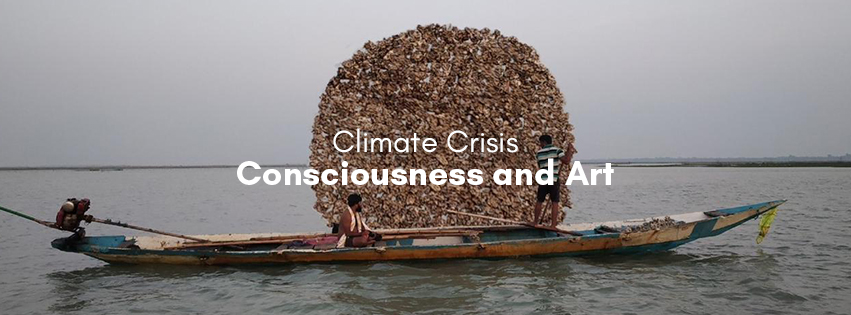The realm of art confides the innate ability to absorb in itself various thoughts that surround the notion of one’s intrinsic individual emotion. Somewhere also when a fraternity of artists culminates in an expression it amplifies their narratives and raises a voice together to give their opinion on the current scenarios. In the evolution of contemporary Indian Art practice, there have been individuals connected through a similar frame of thought, as time demanded artists have stood together to build a Nationalistic approach post-independence, in the past artists have also united by painting posters as a sign of protest and activism and it is also today that a bunch of individuals are painting their opinions as voices on voiceless subject matters.
As it has been witnessed that art has broken barriers to spread awareness and raise questions, today many Indian contemporary artists are working to draw viewers’ immediate attention to the subject of nature, its deterioration, climate change, global warming, melting glaciers, diminishing landscapes, and extincting rivers. The climate crisis calls for our concern and conscious efforts to safeguard Mother Nature at the micro and macro levels. Today, as “Sustainability” becomes a very vague term, one needs to look beneath its so-called abbreviation and practice it in actuality and understand what it means to convey, where art plays a major role in amplifying the voice of nature’s cry.
In contemporary Indian art, many upcoming and established artists are constantly working on exhibiting through their practice, the critical climate change in India, and its impact on the cultural milieu, by formulating alternatives, advocating the use of local materials, and most importantly by critiquing the rapid changes in the society and its impact on climate.
Magesh Ramachandran
Dwelling in the realm of art and weaving the notions of transcendence and transmigration, the art practice of Magesh is derived from forming a visual communication that traces the existence of human society, he has been increasingly fascinated by how tenacious life is and yet how momentary the survival ceases. Where the whole idea of existence is deeply embedded in its cohesive co-existence with the natural ecology, Magesh through his paintings expresses the fragility of human existence. He has been attempting to examine the complicated and chaotic ways in which life contracts, expands, converges, and divests in the personal journeys of human society. Calm and serene landscapes intrigue Magesh, and he connects it to his very being and he emphasizes its power of shaping one-self, making and marking the connection between ecology and mankind. He states the natural cycle has the power to influence our behaviors, emotions, and memories. It can motivate its inhabitants to explore and get lost within it. It can also inspire a fear of the unknown and uncontrollable, reminding us that we are still at the mercy of the forces of nature.
The shared images of his works were recently exhibited at Gallery Splash as a part of a group show, “The Far Edge of the Growing Forest”.
R.Magesh has pursued his practice in Painting, completing his Bachelor’s from Government College of Arts Chennai and Master’s from Faculty of Fine Arts, Vadodara. R.Magesh’s works have been a part of many group shows and he has also been the recipient of many National awards. The artist was also a resident of the “Art and Ecology” program at Space Studio Vadodara.
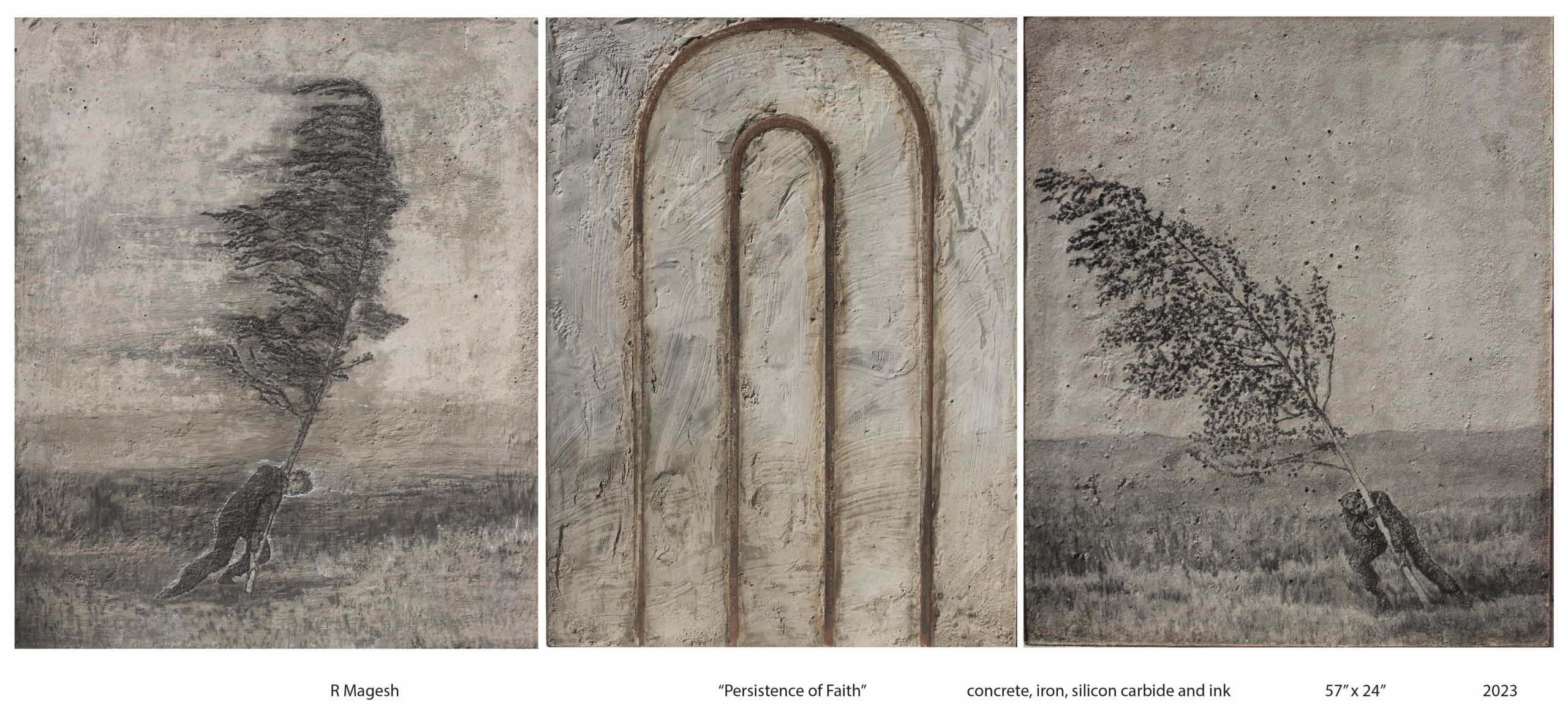
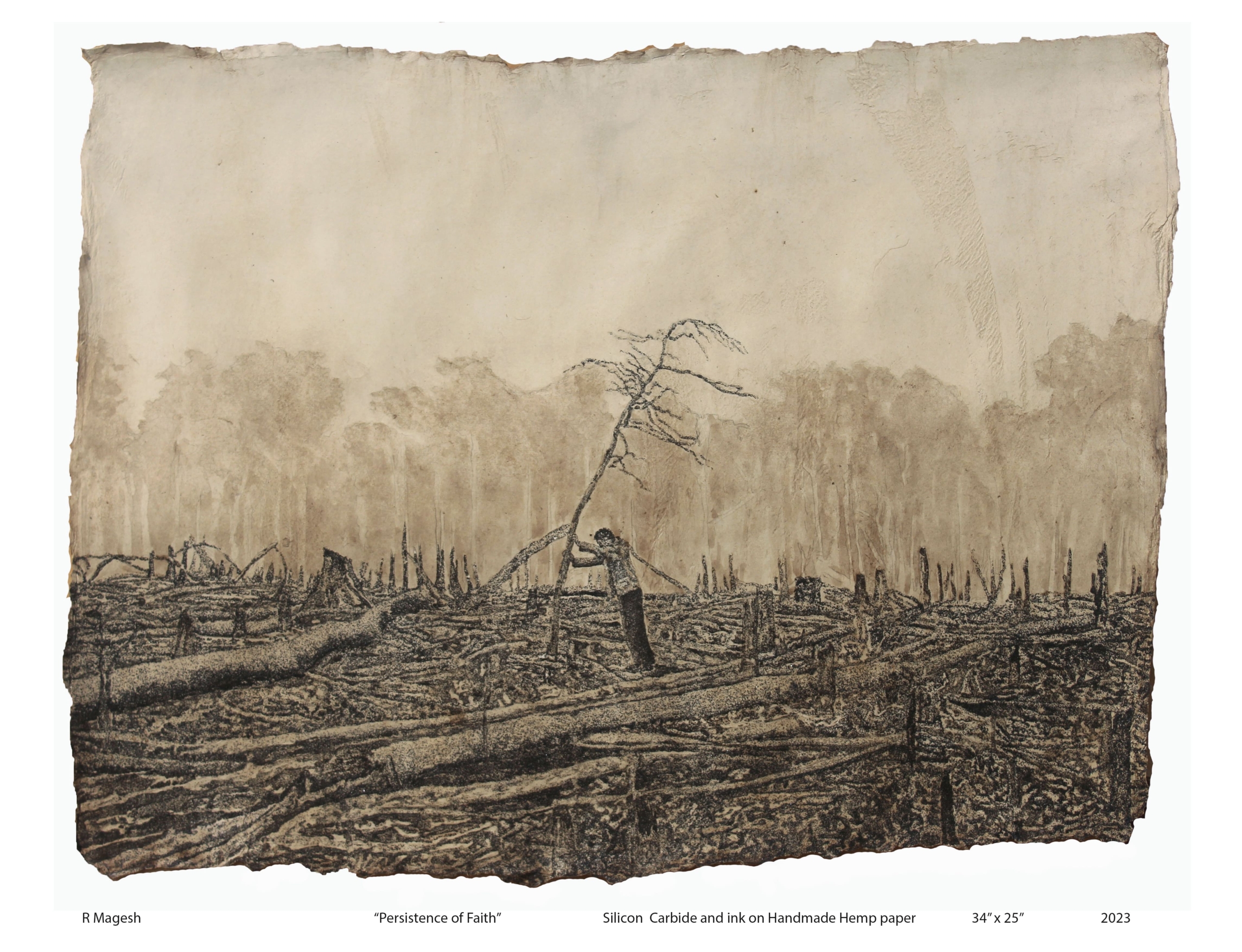
The Shared works were a part of the show, “The Far Edge of Frowing Forest”, displayed at Gallery Splash.
Tapan Moharana
The idea of viewing the world as one society and recognizing the connection between humans and nature is utopic. Temple of Illumination, a site-specific installation by artist Tapan Moharana with sculpture and shadows was envisioned to create an immersive experience for the viewers. The artist here connects mythological references from tales and epics resonating with the ideas of viewing humankind closely connected to nature. In the shared artwork, he narrates the story of Navagunjara, a lesser-known tale, from the epic Odia Mahabharata written by Adi Kabi Sarala Das in the 15th century. In the book, God explains the nature of godliness and the interconnectedness of all living things. As human beings, we can collectively explore the idea of viewing the world as one society and recognizing the connection between humans and nature. Temple of Illumination aims to initiate conversations about the importance of preserving and protecting the environment and understanding the issues that concern humanity. A combination of sculpture and shadows, the work aims to create a site-specific theatrical space, using technology and traditional ways of making to create a hybrid of extraterrestrial imagery. The viewers actively participate in growing awareness of present-day issues. Tapan Moharana explores deeper layers of nature and its connection to humans through cohabitating and contemplating delicate concepts of environmental challenges. He explores different possibilities of the everyday challenges of this relationship, and explores the possibilities of coexistence between humans and the environment rather than weaponizing it. He carefully crafts visual cues and narratives that have the power to highlight various aspects of crises, conflict, displacement, inequality, and environmental degradation. His current practice explores questions about the notions of land, displacement, and the politics of ecology, he mentions he uses his art as a commentary to inform and engage viewers in their concern for social, political, and environmental issues, and he wishes to raise such awareness and concern.
Tapan Moharana is a multidisciplinary artist from Odisha, he lives and works in New Delhi, India. He received his MFA in Sculpture from Rabindra Bharati University, Kolkata. The current practice of Moharana evolves through an amalgamation of various local and indigenous art forms, like shadow puppetry and Shadow Theater practices of his neighborhood.
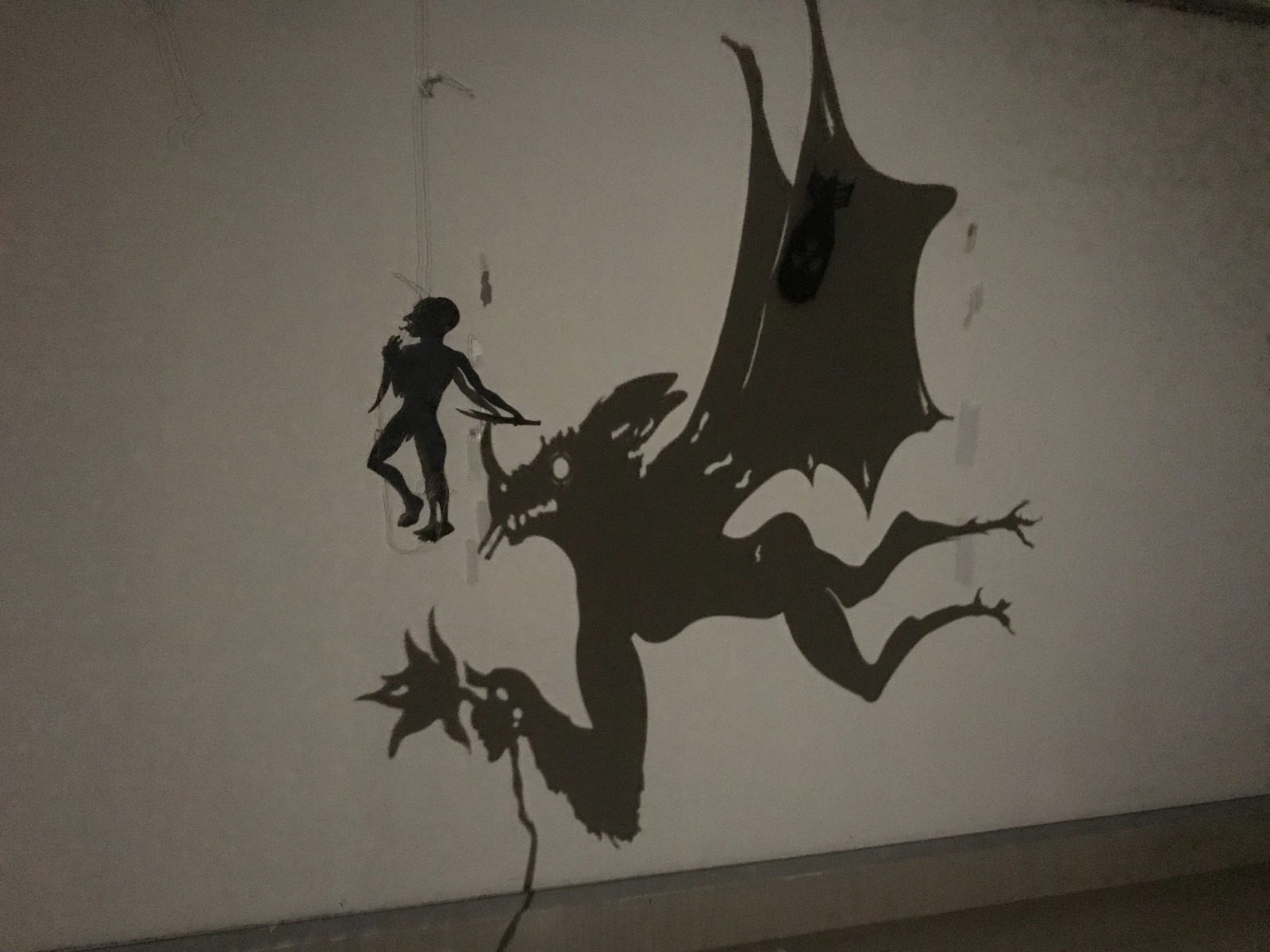
Medium-painted iron, size object A – 150 cm x 165 cm x 1.5 mm. Object B- 22 cm 18cm x 1.5 mm.
The first time it was displayed at The Basic, Bhubaneswar, as one wall project
Yash Desai
Yash Desai’s practice is an exploration of the human race in relation to landscape with the effect of time that leads to the ever-changing surrounding space. His artworks narrate his observations of the fleeting landscapes as they raise many questions about their disappearance and how quickly time, space, and its importance are changing. He explores the dichotomy between rural landscapes and urban complexities, which serves as a rich source of inspiration for his work, allowing him to explore the sublime beauty of nature alongside the intricate layers of human-built environments. Desai draws inspiration from the stark contrast between rural expanses and urban complexities, weaving narratives that explore the harmonious coexistence and inevitable clashes between nature and human intervention. Themes of creation and destruction, chaos, and tranquility emerge as he navigates through these dynamic elements, seeking to capture their essence through his art practice.
His visits to vast landscapes have been the core of his practice that relates to the senses with some places. He attempts to capture the aesthetic of the place, which deliberately lies in knowing he would not see the place exactly the way he was seeing it at that time. The moving landscapes, and the fast changes give a glimpse that the fields might be sooner changed into some other place. For Desai, it is to look at it as much as he can, for it might change maybe due to a calamity or any man-made change and it would never be the same again.
The shared works are a part of Yash Desai’s upcoming group show, “Terra”, conceptualized by Art Incept, and were produced by him during his residency at Space Studio.
Yash Desai graduated from the Faculty of Fine Arts, Vadodara with a Master’s in Printmaking and is currently based in Baroda. In recent years, his exploration of alternative photographic processes and pinhole documentation has added another layer of experimentation to his practice, allowing him to push the boundaries of traditional techniques and discover new ways of expressing them in the present time.
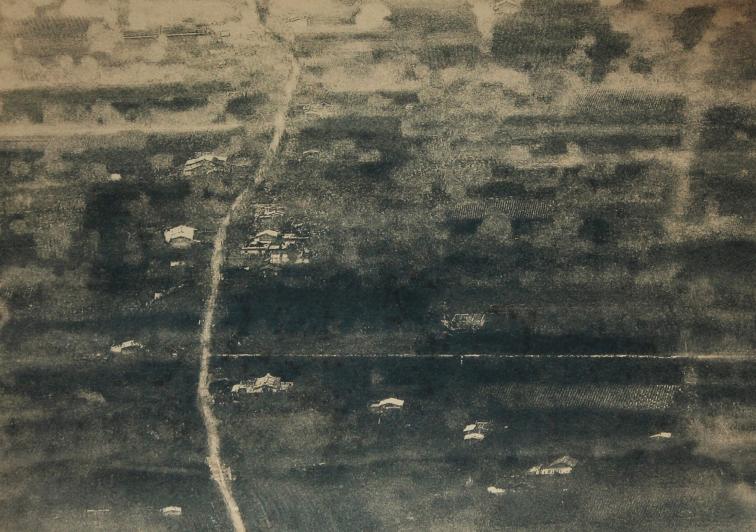
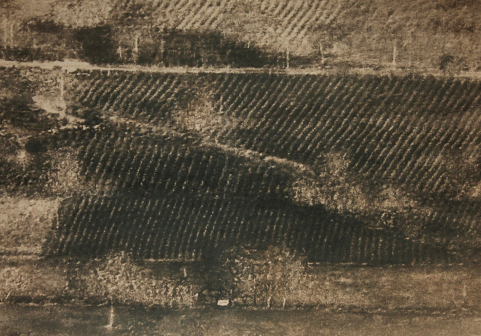
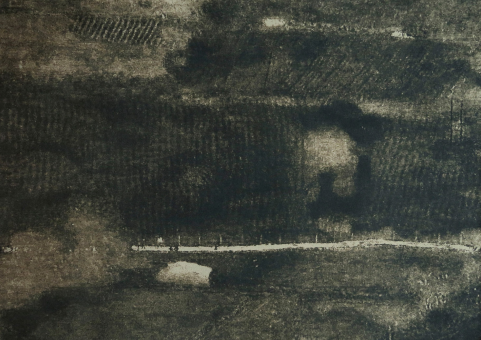
Toned cyanotype, 26×18 inches, 2019
Sashikanth Thavudoz
Sashikanth’s artistic journey immerses viewers in a world where drawing serves as a portal to explore the practical dimensions of form and space. Through his drawings, he crafts immersive experiences that delve into size, scale, and a multitude of techniques to convey the very essence of space. Linear forms breathe life into his works, giving birth to two-dimensional and three-dimensional shapes, thus rendering my art rich in depth and complexity. In recent years Sashikanth has ventured into the intricate relationship between form and space within diverse contexts. The artist’s recent installation at the India Art Fair extended from the traditional confines of studios and galleries to the untamed landscapes and subterranean realms of mines. The interactive artwork immersed with varied experiences shaped his perspective, infusing new layers of depth into his creations. In essence, it viewers into an experience that interweaved form, space, materials, and the profound power they held to communicate ideas of culminating the realms of ecology and nature fused with technology. It defied conventions and acted as a catalyst for meaningful dialogue. His work engaged viewers in profound and thought-provoking ways, unveiling the intricate dance between human-made interventions and the natural world.
The art installation “SYMPHONY OF NATURE: THE HARMONIC FOREST” was a one-of-a-kind, multisensory art installation that offered viewers an immersive experience by seamlessly integrating nature and technology. The wooden columns, illuminated boxes, and plant-generated sound unite to create an environment that fosters reflection on responsible technological progress and the interconnectedness of humanity and the environment. The core idea of this installation revolved around the harmonious coexistence of natural and man-made elements. The wooden columns represent nature’s enduring strength and resilience, while the illuminated boxes attached to them symbolize the ever-evolving nature of technology. The groundbreaking element of this installation lay in the conversion of changes in the electrical conductivity of plants into audio, allowing the flora to sing in harmony. This innovative approach emphasizes the importance of aligning progress with environmental responsibility
Visitors to “Symphony of Nature: The Harmonic Forest” engaged with the installation on multiple levels. They walked through the forest-like grid, experienced the shifting colors of the illuminated boxes, and listened to the captivating plant-generated soundscape. This interactive engagement encouraged deep contemplation about the coexistence of nature and technology and the imperative of responsible progress.
Sustainability is a fundamental consideration for this installation. Eco-friendly materials were used throughout to minimize environmental impact, aligning with the project’s core message of environmental responsibility.
Sashikanth is originally from Hyderabad, India. Currently, he is actively practicing in Vadodara. In 2011, he earned my Master of Visual Arts (MVA) from the Faculty of Fine Arts at Maharaja Sayajirao University in Vadodara. Notable exhibitions include displays at the Lecart Art Gallery in Canada in 2018, “Imitating Atmosphere” at the Jaipur Sculpture Park in Rajasthan in 2018-19, and participation in the prestigious India Art Fair in New Delhi in 2019 and 2020.
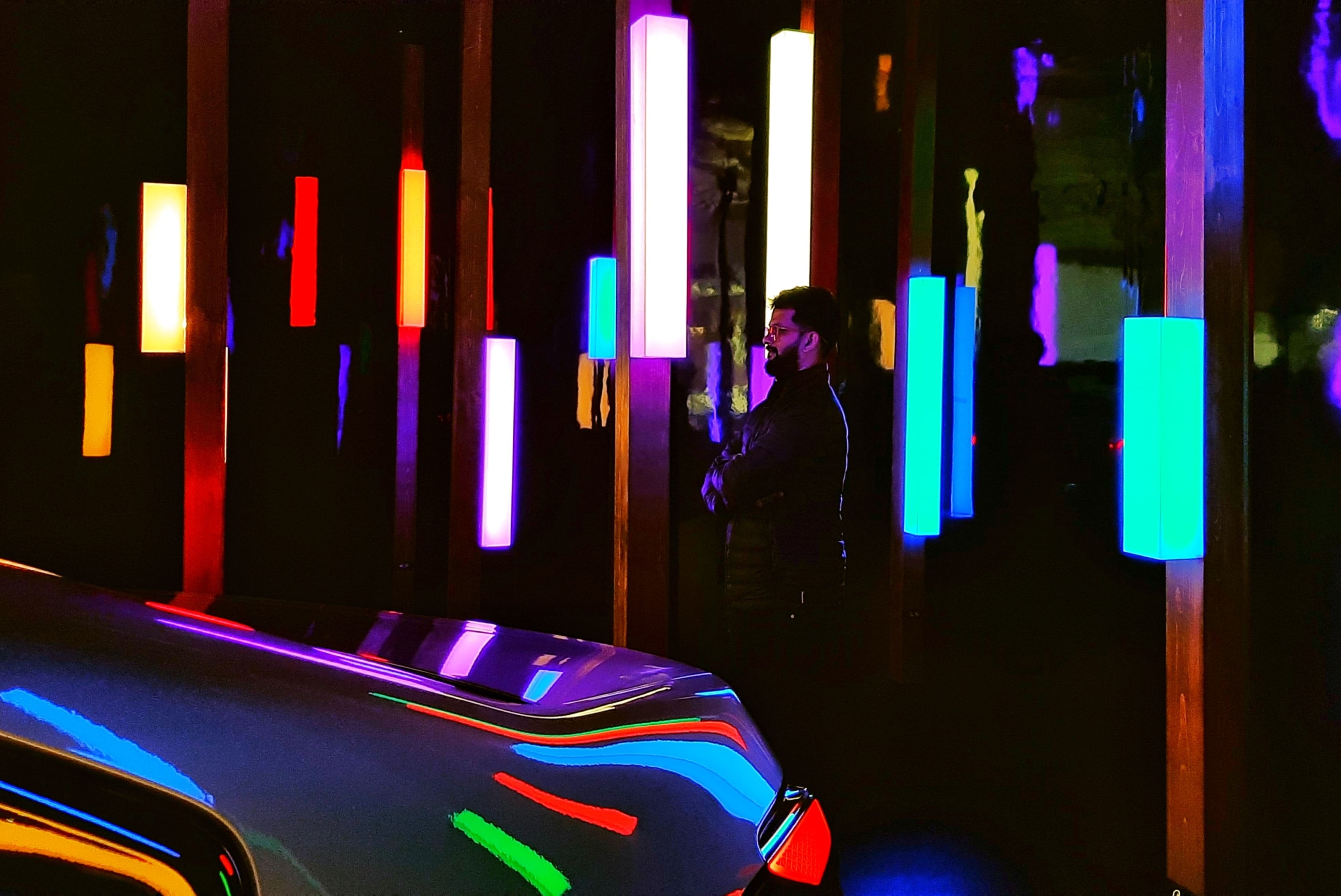
Installation “Symphony of Nature: The Harmonic Forest” at India Art Fair 2024
Pinaki Mohanty
Pinaki Mohanty’s artworks are based on activities of his daily life and experiences. In his works, he depicts his surroundings and what affects him the most is the humor and pathos of moments from his childhood and adult life. His artworks reproduce familiar visual signs, arranging them into new conceptual layered pieces. His works are often depicted in a range of different media, grouped around specific themes and meanings. During the creation of every work, new areas of interest arise and lead him to the next experimental work. His work tends to focus on the environment, the evolution of man, and his material wealth. Some of his subject matter is about people’s daily routines and are his comments on human nature. The Lake Chilika and its surroundings, as his physical and spiritual birthplace, are a perennial source of inspiration for his work. The study of its history and literature through the eyes of myriad poets and writers lets him investigate its existence through multiple time zones. Each is replete with its own beauty, pain, and perspectives that he tries to illustrate with his work. Literature has become a huge influence in his recent works with both verse and prose playing a role in the evolution of his inquiry.
Pinkai was born in a small village by Lake Chilika – the largest coastal lagoon in India. The Blue Lagoon is a delicate ecosystem with birds, fish, mammals, and human beings all playing out their parts. It has inspired Odia poetry and prose over generations and attracted travelers from all over the world to witness the annual migration of birds in winter to its shores. Sadly, in recent years, the beautiful lake of his childhood has come under siege due to repeated depredations by humanity and is now amid a major conservation crisis. The problems of the lake are entangled with complicated fishing rights, a decrease in lake-water salinity, loss of biodiversity, and choking of the inlet channel to the lake. His practice focuses on documenting and raising awareness of this gradual degradation of the beautiful lagoon he calls home. He has spent the last several years extensively documenting this change by means of photographs, videos, audio recordings, collecting found objects, etc. These form the basis of an extensive archive that takes up a substantial part of his village home. He has also collected a substantial amount of literature on Chilika -fiction and non-fiction, prose, and poetry- that influences his work heavily. He has also built installations in the lake to raise awareness and sensitivity towards the lake among tourists and locals alike.
Pinaki Ranjan Mohanty is a Bhubaneswar, Odisha-based sculptor. He has completed a Bachelor of Fine Arts (Sculpture) from B.K. College of Art & Crafts, Bhubaneswar in 2007 and pursued his Post Graduate Diploma in Ceramics Design from Kala Bhavan, Visva Bharati, Shantiniketan in 2013.
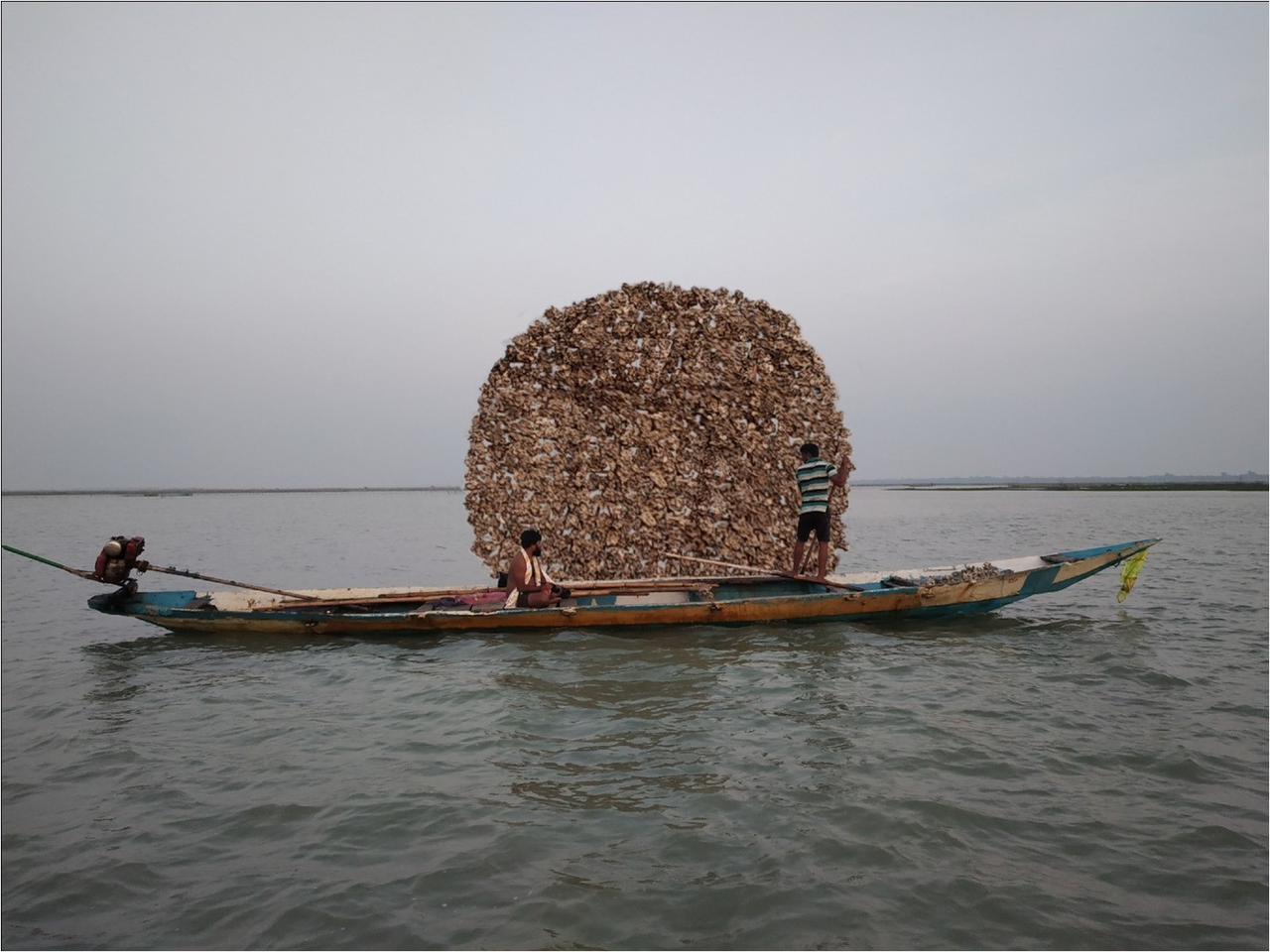
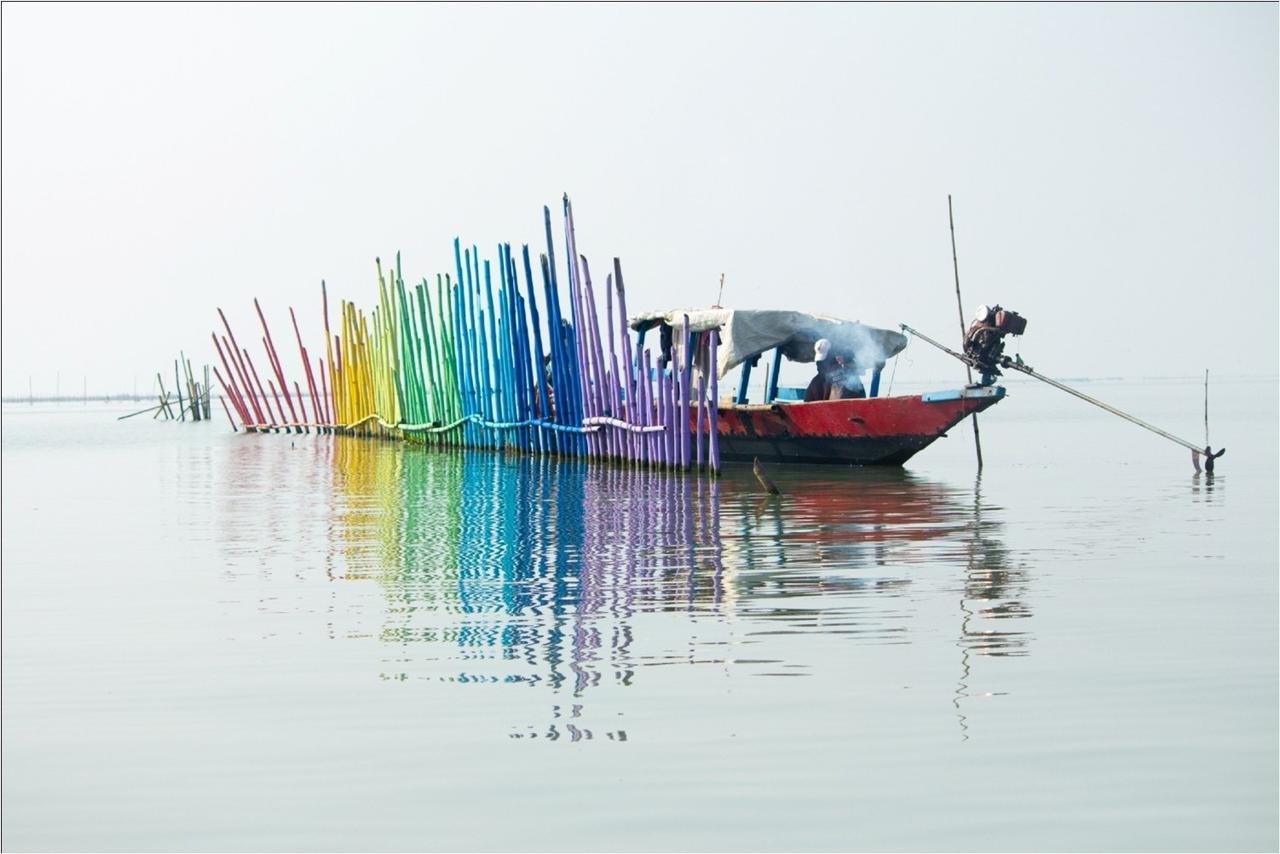
Clilika Dialogs, Site-specific Installations, Variable at different locations of Lake Chilika, 2019-20
Project Support by: Serendipity Visual Art Grant 2019-20
Image 1: Title _ Rotiya Chandra Size _ 10ft Dia Medium _ sea shell Displayed at – exhibited at Chitika lake
Image 2: Title _ sayantaniya Drusya Size _ 80 ft long. High 15’ft Medium_bamboo, Natural pigment color Displayed at – exhibited at Chilika Lake
Photo credit: Biswajit Sahani
Sneh Mehra
Sneh Mahra’s work is primarily about land and environment and consists of other interdisciplinary layers, which revolve around it to become a body of entitlement. Reflecting on her surroundings and the fragments of haphazard growth and deterioration are the references that drive the impulse of her work henceforth highlight the objective reality of nature, which is omnipresent but gets neglected and disdained in the present scenario due to the overpowering dominance of inter-subjective realities. Further, she has an intense urge to paint and gesticulate herself, which highly influences her process of painting i.e. the adding and removing of paint in painting mostly canvas, paper, and collage on paper.
She likes to paste any visual reference if it is on paper or paint from a photograph initially if on canvas and scratch some unwanted areas or add more and erase. This act of adding and removing in a way makes her aware of my subconscious.
Visual reference and photographs are mostly taken from newspaper cutouts, old collected Magazines, Movie stills, or my own photography; culminate into works that manifest my surroundings invariably, reflecting Environmental issues, change in climate, and its impact on mundane life.
She likes to incorporate works with high influence from Benode Bihari Mukherjee, Shibu Natesan, David Hockney, Peter Doig, and Francis Bacon.
She wants to emphasize on the painting medium itself as she have mentions earlier of her urge to achieve a painterly language in a period of post-modern sensibilities and critical thinking when there is an influx of new mediums and approaches that are marking exuberant varieties in the field of fine art. She relies on the contemporary executions of specific academic mediums such as oil and drawings. She wished to explore more of such painterly quality and wander upon things that are yet to be explored with this medium.
One can zoom out and see her work from a perspective where it is not too close and not too far, to understand the anthropological aspect of it, which carries interdisciplinary layers as she mentioned before. It revolves around the evolution of land, environment and ecology, climate change, animal behavior, and its symbiotic relationship with human existence. These all are staged in landscape regime, which in the history of art has always been part of the background of portraits or rather was limited to natural scenery depicting mountains, rivers, skies, and beaches. In the contemporary realm of painting, the artist often dabbles in a style inspired by past artistic movements. One genre that excites her is “Landscape painting” and the change that has happened is ‘Destruction’ being part of our daily surrounding environment, the source is derived from my encounters with the current scenario, where it is crucial to talk about climate change and Landscape, perhaps depict it visually, to transcend it into individual’s subconscious. She likes to work on this particularly because it overlaps with her work and she has gradually worked on it for the past six years.
Born in 1990, in Surat, Sneh Mehra earned her BFA in Painting from Surat College of Fine Art VNSGU, Surat (2008-12), and Later received her MFA from S.N School of Fine Arts, University of Hyderabad (2013-15). She primarily works with oil on canvas. She works in landscape format, which reflects her surroundings and their haphazard growth and deterioration, and aspires to explore the abounding organic unplanned labyrinth to form ominous layers of skylines. She Currently Pursuing her second master’s in fine arts at the University of East London.
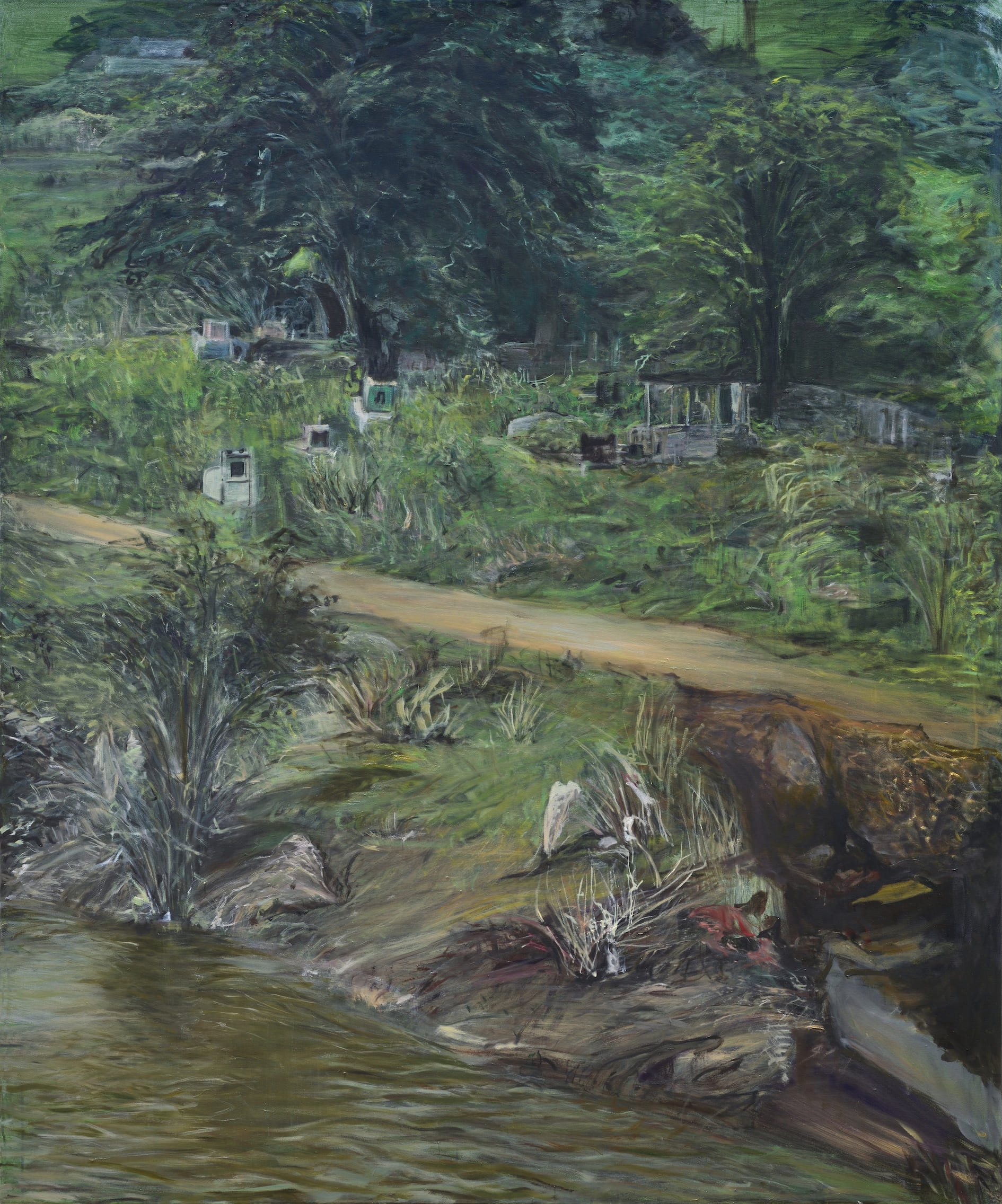
Title: River Road.
Size: 152 x 183cm
Medium: Acrylic and oil canvas.
Year: 2021, Displayed at – exhibited at Gallery Dotwalk.
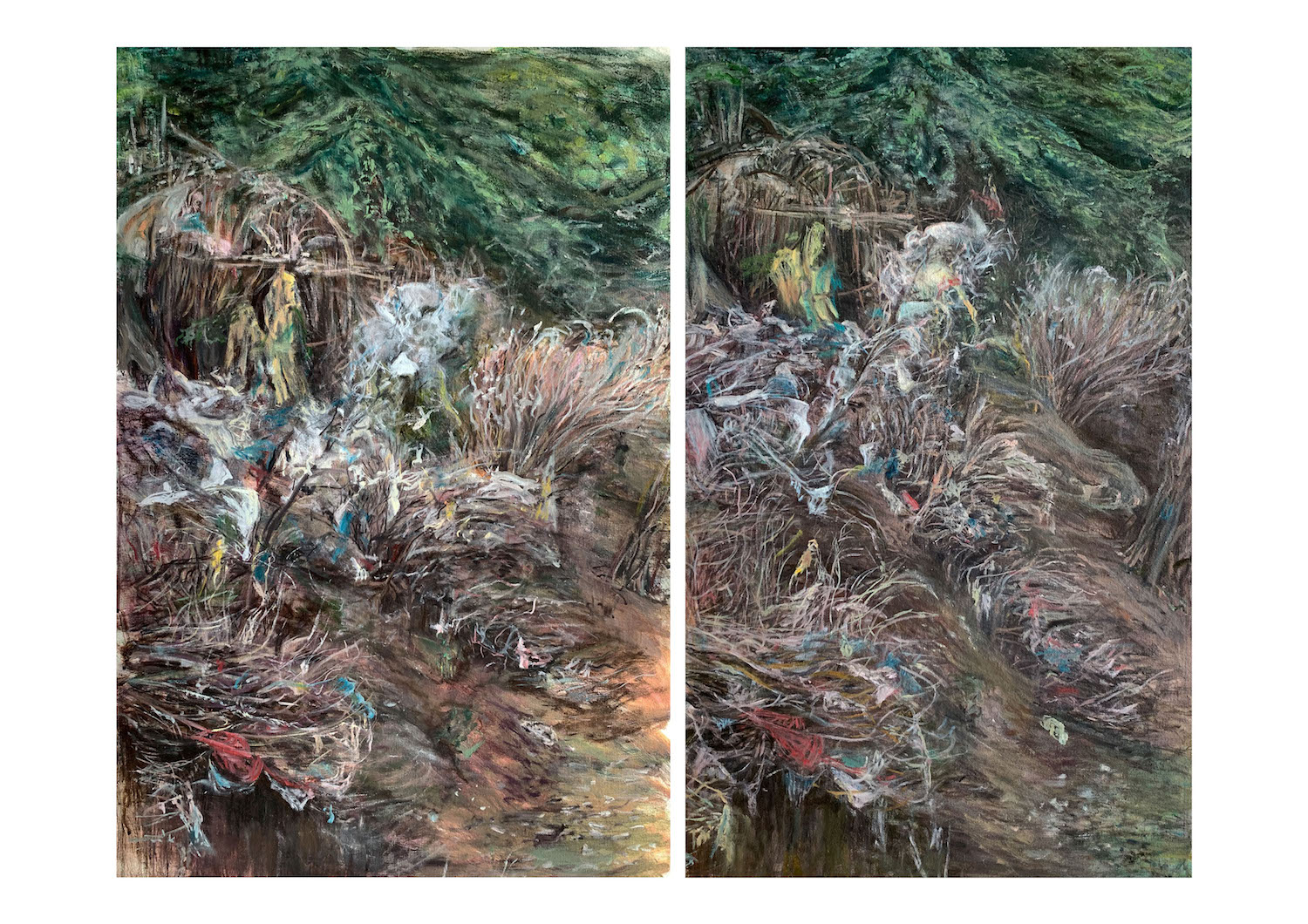
Title: Anywhere Everywhere.
Size: 78 x 104 cm
Medium: Acrylic and oil on canvas.
Year: 2020.
Displayed at ‘Breathing Through shifting Space’, Sakshi Gallery Colaba, Mumbai 2020
Words by Dhara Mayavat, she is an Architect and Art Historian, graduated from the Faculty of Fine Arts, Baroda. She has been working in the realm of Museums, Archiving, and writing on cultural heritage. Her research and documentation practices are rooted in close observations of the diverse sustainable cultural traditions of South Asia, innately covering subjects of indigenous art.

